“Knowledge, understanding and awareness hopefully will stop and bring the circle forward.”
Get the latest from Catherine Morrison straight to your inbox
Published Sep 30, 2023 • Last updated 35 minutes ago • 5 minute read
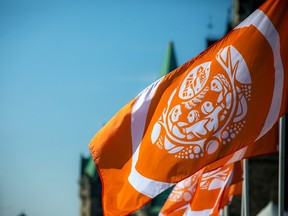 Parliament Hill was a sea of orange on Saturday for the event held to mark the National Day for Truth and Reconciliation. Photo by Ashley Fraser /Postmedia
Parliament Hill was a sea of orange on Saturday for the event held to mark the National Day for Truth and Reconciliation. Photo by Ashley Fraser /Postmedia
Hundreds of people from across Canada wearing orange shirts and ribbon skirts made their way to Parliament Hill on Saturday in recognition of the third annual National Day for Truth and Reconciliation.
They gathered for “Remembering the Children,” a broadcast event co-hosted by the National Centre for Truth and Reconciliation and the Aboriginal Peoples Television Network honouring residential school survivors, their families, communities and the children who never made it home.
Advertisement 2
This advertisement has not loaded yet, but your article continues below.
THIS CONTENT IS RESERVED FOR SUBSCRIBERS ONLY
Subscribe now to read the latest news in your city and across Canada.
Exclusive articles from Elizabeth Payne, David Pugliese, Andrew Duffy, Bruce Deachman and others. Plus, food reviews and event listings in the weekly newsletter, Ottawa, Out of Office.Unlimited online access to Ottawa Citizen and 15 news sites with one account.Ottawa Citizen ePaper, an electronic replica of the print edition to view on any device, share and comment on.Daily puzzles, including the New York Times Crossword.Support local journalism.
SUBSCRIBE TO UNLOCK MORE ARTICLES
Subscribe now to read the latest news in your city and across Canada.
Exclusive articles from Elizabeth Payne, David Pugliese, Andrew Duffy, Bruce Deachman and others. Plus, food reviews and event listings in the weekly newsletter, Ottawa, Out of Office.Unlimited online access to Ottawa Citizen and 15 news sites with one account.Ottawa Citizen ePaper, an electronic replica of the print edition to view on any device, share and comment on.Daily puzzles, including the New York Times Crossword.Support local journalism.
REGISTER TO UNLOCK MORE ARTICLES
Create an account or sign in to continue with your reading experience.
Access articles from across Canada with one account.Share your thoughts and join the conversation in the comments.Enjoy additional articles per month.Get email updates from your favourite authors.
Article content
Article content
Poles flying the Survivors’ Flag lined the lawn, with Canadian flags on the Parliament buildings at half-mast.
Many attendees huddled by a stage in front of Parliament’s West Block, with others sitting further back on the lawn or watching the show from Wellington Street. Some attendees carried posters, with one person holding a poster with “Every Child Matters” written on it and another person holding a poster calling for a search of the Winnipeg landfill where it’s thought the remains of two murdered Indigenous women may be.
Douglas Gerrard, an Indigenous spiritual care provider at the Brandon Correctional Centre in Manitoba, was one of the invited guests for the ceremony.
The grandson and son of residential school survivors and a day school survivor, Gerrard said it was an “honour and a privilege” to represent his family, community and loved ones.
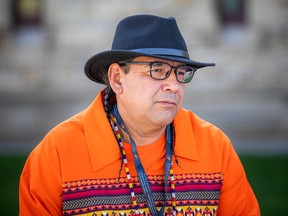 Douglas Gerrard, an Indigenous spiritual care provider at a Manitoba correctional centre, was one of the invited guests for Saturday’s ceremony. Photo by Ashley Fraser /Postmedia
Douglas Gerrard, an Indigenous spiritual care provider at a Manitoba correctional centre, was one of the invited guests for Saturday’s ceremony. Photo by Ashley Fraser /Postmedia
“The effect has cascaded to even my children,” Gerrard said of residential schools, adding that the institutions had an impact on the loss of Indigenous language speakers and that he himself knows little of his language. “It’s (up to) my generation, my children, my grandchildren to pick up those pieces. We’re still here, we’re still fighting. We still have our drum, our ceremony. They couldn’t take those away because of our spirits.”
Advertisement 3
This advertisement has not loaded yet, but your article continues below.
Article content
Practising spiritual care since he was six years old, Gerrard said he works with the Brandon correctional centre’s staff and residents, providing healing through practices like sweats, smudging ceremonies and counselling, and he also works to support his community.
Gerrard said the Sept. 30 event was “for everyone,” both Indigenous and non-Indigenous. He added the event provided an opportunity for people to heal and learn about the suffering and pain that Indigenous people had faced and continued to face.
Moving towards reconciliation, Gerrard said it was crucial that there be more awareness of the culture and spirituality of Indigenous peoples within institutions. He added that more needed to be done to support the country’s homeless population, which includes many Indigenous people, and there was a particular need for non-Indigenous non-profit organizations to help Indigenous people.
“Knowledge, understanding and awareness hopefully will stop and bring the circle forward,” Gerrard said. “It’s still broken, but the non-Indigenous institutions, the government, are slowly pushing that piece back into that circle, like a jigsaw puzzle. Indigenous peoples were the missing piece, so we’re trying to fit it in there, and, once it fits in, then we could see prosperity and harmony.”
Advertisement 4
This advertisement has not loaded yet, but your article continues below.
Article content
Events took place from coast to coast to commemorate Orange Shirt Day. In Ottawa, the Canadian Museum of History invited visitors to participate in a reflective activity by writing, drawing or colouring on cards to join the conversation on truth and reconciliation, and the Beechwood Cemetery Foundation hosted a short video screening and a reconciliation tour of its grounds.
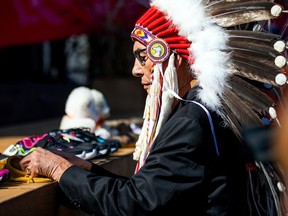 Chief Wilton “Willie” Littlechild places a pair of moccasins in honour of those children who did not return home from residential schools. Photo by Ashley Fraser /Postmedia
Chief Wilton “Willie” Littlechild places a pair of moccasins in honour of those children who did not return home from residential schools. Photo by Ashley Fraser /Postmedia
The 90-minute event on Parliament Hill was hosted by Charles Bender and Madeleine Allakariallak and included performances by the Eagle River Singers, Eddie Cote, Emma Stevens, Willows, Terry Uyarak, Ry Moran and Aysanabee.
Guest speakers included the University of Ottawa’s first Indigenous chancellor, Claudette Commanda, former commissioner to the Truth and Reconciliation Commission of Canada Dr. Wilton Littlechild and Canada’s first Indigenous Governor General, Mary Simon.
In her speech, Simon said reconciliation was a complex issue, given that survivors had their own experiences and needed to heal in their own time, and there were many levels of work required at both the community and political levels. However, she said, reconciliation is ultimately about respect.
Advertisement 5
This advertisement has not loaded yet, but your article continues below.
Article content
“Reconciliation is a way of saving and living life, it is about being intentional in how we interact with one another, how we show respect, how we get rid of racism, how we make space to respect each other and our cultures,” Simon said. “It’s a time to get to know each other, it’s a time to tell our stories, a time to exchange and tell each other who we are so that, in the end, we will learn as people of this country to be the type of people we want to be.”
One of the most emotional moments of the event was when a red memorial banner bearing names of children who didn’t make it home from residential schools was carried through the sea of orange onto the stage and folded.
To pay their respects of those children, those on the Hill were invited to place shoes on a platform at the front of the stage.
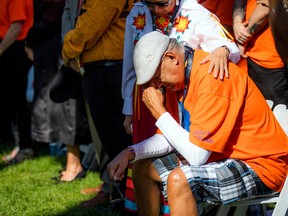 Residential school survivors and their supporters were full of emotions as a banner bearing the names of children who did not come home moved onto the stage on Saturday. Photo by Ashley Fraser /Postmedia
Residential school survivors and their supporters were full of emotions as a banner bearing the names of children who did not come home moved onto the stage on Saturday. Photo by Ashley Fraser /Postmedia
Caroline Lalonde, whose spirit name is Shipek Mikunis Muashk Totem (Feather falling to the ocean), said the event was “really sad, but also really beautiful.” A Midewiwin learning to practice healing methods, Lalonde is from Sachigo Lake First Nation in Northwestern Ontario.
“I’m happy to see that it’s being talked about. We’re in the beginning stages of reconciliation and just not forgetting the children who we lost, but also remembering my family members who have gone through it,” Lalonde said, adding that she had family members who were in residential schools and that her grandmother was is in an “Indian hospital,” where she was bed-ridden and subjected to medical experiments.
Advertisement 6
This advertisement has not loaded yet, but your article continues below.
Article content
In terms of reconciliation, Lalonde said she thought “we’re on the path,” adding there needed to be greater awareness of the atrocities faced by Indigenous peoples. She added she’d like to see Sept. 30 become a statutory holiday across all provinces.
“We’re just the beginning stages. We all started talking about this a few years ago,” Lalonde said. “I’m happy to see that we’re getting a lot of support from not just Indigenous people trying to fight for action, but other Canadians are coming of all races and backgrounds.”
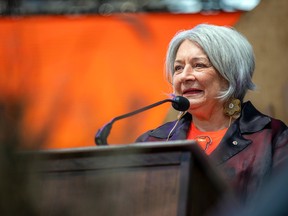 Gov.-Gen. Mary Simon addresses the crowd at Parliament Hill on Saturday afternoon. Photo by Ashley Fraser /Postmedia
Gov.-Gen. Mary Simon addresses the crowd at Parliament Hill on Saturday afternoon. Photo by Ashley Fraser /Postmedia 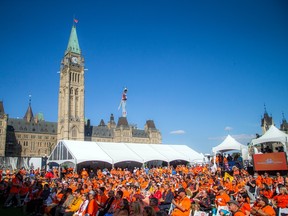 Parliament Hill was a sea of orange for the event marking National Day for Truth and Reconciliation. Photo by Ashley Fraser /Postmedia
Parliament Hill was a sea of orange for the event marking National Day for Truth and Reconciliation. Photo by Ashley Fraser /Postmedia 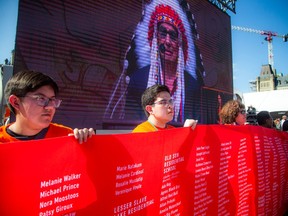 A long banner displays names of children who did not come home from residential schools. Photo by Ashley Fraser /Postmedia
A long banner displays names of children who did not come home from residential schools. Photo by Ashley Fraser /Postmedia 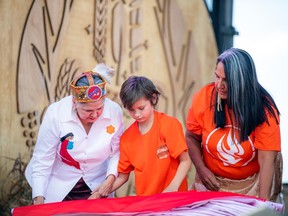 Parliament Hill was a sea of orange as a gathering for the National Day for Truth and Reconciliation event on Saturday. Photo by Ashley Fraser /Postmedia
Parliament Hill was a sea of orange as a gathering for the National Day for Truth and Reconciliation event on Saturday. Photo by Ashley Fraser /Postmedia
Related Stories

Deachman: Answering 94 Calls to Action will take time. But let’s not take too much

Can Renée Amilcar save OC Transpo?
Article content
>>> Read full article>>>
Copyright for syndicated content belongs to the linked Source : OttawaCitizen – https://ottawacitizen.com/news/local-news/national-day-for-truth-and-reconciliation-event-on-parliament-hill-provides-a-time-for-healing-learning































